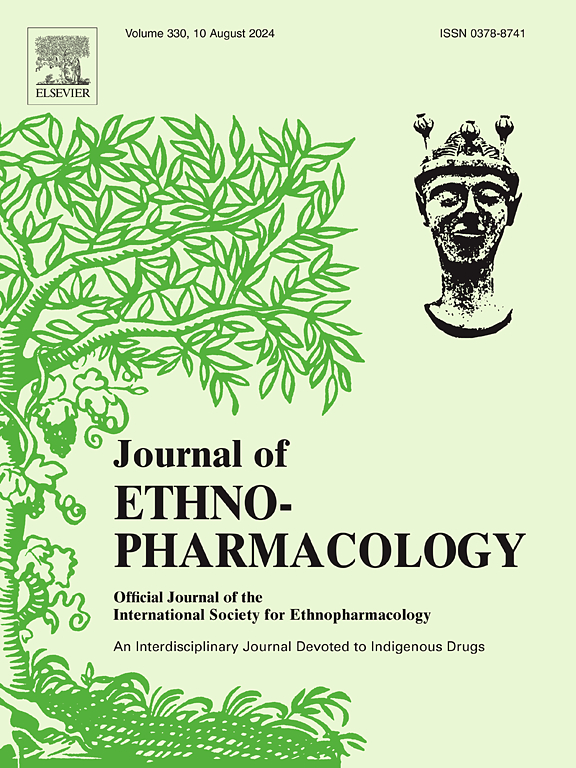To establish a new quality assessment method based on the regulation of intestinal microbiota in type 2 diabetes by lignans of Schisandra chinensis (Turcz.) Baill
IF 4.8
2区 医学
Q1 CHEMISTRY, MEDICINAL
引用次数: 0
Abstract
Ethnopharmacological relevance
The mature fruit of Schisandra chinensis, a traditional Chinese medicinal herb, is primarily utilized for the management of diabetes. Its principal bioactive constituents include lignans, polysaccharides, and organic acids. Nonetheless, a standardized quality control methodology grounded in the therapeutic efficacy of Schisandra chinensis (Turcz.) Baill. for diabetes treatment has yet to be developed.
Aim of the study
Due to the diverse origins, intricate composition, and multiple therapeutic targets of Schisandra chinensis Fructus, relying on a single index component for quality control is challenging. Consequently, this study proposes a novel quality evaluation approach, integrating pharmacological activity and intestinal microbiota analysis, to assess the efficacy of Schisandra chinensis Fructus in diabetes management.
Materials and methods
Twelve batches of Schisandra chinensis Fructus from diverse origins were selected for lignan content analysis, and 3 representative batches were subsequently chosen for pharmacological experiments pertaining to diabetes. The relationship between lignan content in Schisandra chinensis Fructus and its pharmacological efficacy was assessed by evaluating the recovery rates of eleven serum biochemical markers affected by Schisandra lignans. Furthermore, 16S rRNA gene sequencing was utilized to explore the association between the gut microbiota in diabetic rats and the lignan content in Schisandra chinensis Fructus.
Results
The results of serum biochemistry analyses demonstrate that Schisandra lignans significantly decrease bone gamma-carboxyglutamate protein (BGP), blood lipid levels, and oxidative stress in diabetic rats, thereby conferring hepatoprotective effects. Correlation analysis between the constituents and pharmacological effects revealed a positive relationship between the anti-diabetic efficacy of Schisandra chinensis Fructus and its total lignan content. Furthermore, Schisandra lignans were observed to enhance gut microbiota diversity in diabetic rats, mitigate the dysbiosis induced by Type 2 Diabetes Mellitus (T2DM), and increase the abundance of beneficial bacterial species.
Conclusions
The observed variations in the efficacy of Schisandra chinensis Fructus from different sources may be attributed to differences in total lignan content. The higher the total lignan content in Schisandra chinensis Fructus, the stronger its protective effect. Based on the analysis of component-efficacy-microbiota correlation this study has identified a chisandrin content of ≥3.5 mg/g and a total lignan content of≥17 mg/g as quality evaluation indicators for the improvement of T2DM by Schisandra chinensis Fructus.

求助全文
约1分钟内获得全文
求助全文
来源期刊

Journal of ethnopharmacology
医学-全科医学与补充医学
CiteScore
10.30
自引率
5.60%
发文量
967
审稿时长
77 days
期刊介绍:
The Journal of Ethnopharmacology is dedicated to the exchange of information and understandings about people''s use of plants, fungi, animals, microorganisms and minerals and their biological and pharmacological effects based on the principles established through international conventions. Early people confronted with illness and disease, discovered a wealth of useful therapeutic agents in the plant and animal kingdoms. The empirical knowledge of these medicinal substances and their toxic potential was passed on by oral tradition and sometimes recorded in herbals and other texts on materia medica. Many valuable drugs of today (e.g., atropine, ephedrine, tubocurarine, digoxin, reserpine) came into use through the study of indigenous remedies. Chemists continue to use plant-derived drugs (e.g., morphine, taxol, physostigmine, quinidine, emetine) as prototypes in their attempts to develop more effective and less toxic medicinals.
 求助内容:
求助内容: 应助结果提醒方式:
应助结果提醒方式:


